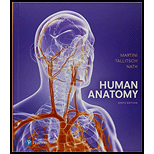
EBK HUMAN ANATOMY
9th Edition
ISBN: 9780134424828
Author: Nath
Publisher: YUZU
expand_more
expand_more
format_list_bulleted
Concept explainers
Textbook Question
Chapter 18, Problem 5RFT
Deep to the subcutaneous layer, the eyelids are supported by broad sheets of connective tissues, collectively termed the
(a) eyelids.
(b) tarsal plate.
(c) chalazion.
(d) medial angle.
Expert Solution & Answer
Want to see the full answer?
Check out a sample textbook solution
Students have asked these similar questions
Which of the following components listed is not a part of the spiral organ? (a) the tectorial membrane, (b) the inner hair cells, (c) the outer hair cells, (d) the spiral ganglion.
The part of the fibrous layer of the eye that is white, tough, and opaque is the (a) choroid, (b) cornea, (c) retina, (d) sclera.
What is the usual result if a sebaceous gland of an eyelash or a tarsal gland becomes infected?
Chapter 18 Solutions
EBK HUMAN ANATOMY
Ch. 18 - Using the diagram, fill in the blanks below with...Ch. 18 - 2. A receptor that is especially common in the...Ch. 18 - Fine touch and pressure receptors provide detailed...Ch. 18 - Receptors in the saccule and utricle provide...Ch. 18 - 5. Deep to the subcutaneous layer, the eyelids are...Ch. 18 - Prob. 6RFTCh. 18 - Prob. 7RFTCh. 18 - Mechanoreceptors that detect pressure changes in...Ch. 18 - Prob. 9RFTCh. 18 - Auditory information about the frequency and...
Ch. 18 - Fill in the blanks below with the proper...Ch. 18 - Prob. 1RCCh. 18 - Prob. 2RCCh. 18 - 3. A person salivates when anticipating eating a...Ch. 18 - Prob. 4RCCh. 18 - 5. What could stimulate the release of an...Ch. 18 - Prob. 6RCCh. 18 - Prob. 7RCCh. 18 - Prob. 8RCCh. 18 - Prob. 9RCCh. 18 - Prob. 10RCCh. 18 - 1. Beth has surgery to remove some polyps...Ch. 18 - 2. Jared is 10 months old, and his pediatrician...Ch. 18 - Prob. 3CT
Knowledge Booster
Learn more about
Need a deep-dive on the concept behind this application? Look no further. Learn more about this topic, biology and related others by exploring similar questions and additional content below.Similar questions
- Select the best answer or answers from the choices given: Accessory glands that produce an oily secretion are the (a) conjunctiva, (b) lacrimal glands, (c) tarsal glands.arrow_forwardIf the eyelid is still present, note its structure and the presence of eyelashes'-What is the function of the eyelid and eyelashes?arrow_forwardThe function of tears produced by the lacrimal apparatus is to: (a) keep conjunctival surfaces moist and clean. (b) reduce friction and remove debris from the eye. (c) provide nutrients and oxygen to the conjunctival epithelium. (d) a, b, and c are correct.arrow_forward
- Which of the following extrinsic eye muscles listed does not originate from the common tendinous ring? (a) superior oblique, (b) inferior oblique, (c) superior rectus, (d) inferior rectus.arrow_forwardThe malleus, incus, and stapes are the tiny ear bones located in the, (a) external ear. (b) middle ear. (c) internal ear. (d) membranous labyrinth.arrow_forwardSelect the best answer or answers from the choices given: The sensations of touch and pressure are picked up by receptors located in (a) the stratum spinosum, (b) the dermis, (c) the hypodermis, (d) the stratum corneum.arrow_forward
- What is the function of the uvula?arrow_forwardYou saw a lady who was hard hit by a motorcycle. She readily fell on the ground and became unconscious. The victim acquired a laceration, about 4 inches in length, at the left crus and a broken left pollex. The motorcycle driver on the other hand fell on the ground, conscious, and acquired a large abrasion on the right olecranal area. You and some bystanders have witnessed the accident. What will be your response? Assume that you are a licensed first aider and you have all the materials needed with you.arrow_forwardParalysis of a medial rectus muscle would affect (a) accommodation,(b) refraction, (c) depth perception, (d) pupil constriction.arrow_forward
- Select the best answer or answers from the choices given: The large onion-shaped receptors that are found deep in the dermis and in subcutaneous tissue and that respond to deep pressure are (a) tactile discs, (b) lamellar corpuscles, (c) free nerve endings, (d) muscle spindles.arrow_forwardThe receptors for static equilibrium that report the position of the head in space relative to the pull of gravity are in the (a) spiral organ, (b) maculae, (c) crista ampullaris, (d) ampullary cupulae, (e) joint kinesthetic receptors.arrow_forwardDefine thoracolumbar divisionarrow_forward
arrow_back_ios
SEE MORE QUESTIONS
arrow_forward_ios
Recommended textbooks for you

12DaysinMarch, Genital Infections for USMLE Step One; Author: Howard Sachs;https://www.youtube.com/watch?v=66zR_FypVFQ;License: Standard youtube license